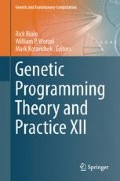Abstract
From a recent study, we know that if we are able to find two optimally aligned individuals, then we can reconstruct a globally optimal solution analytically for any regression problem. With this knowledge in mind, the objective of this chapter is to discuss two Genetic Programming (GP) models aimed at finding pairs of optimally aligned individuals. The first one of these models, already introduced in a previous publication, is ESAGP-1. The second model, discussed for the first time here, is called Pair Optimization GP (POGP). The main difference between these two models is that, while ESAGP-1 represents solutions in a traditional way, as single expressions (as in standard GP), in POGP individuals are pairs of expressions, that evolution should “push” towards the optimal alignment. The results we report for both these models are extremely encouraging. In particular, ESAGP-1 outperforms standard GP and geometric semantic GP on two complex real-life applications. At the same time, a preliminary set of results obtained on a set of symbolic regression benchmarks indicate that POGP, although rather new and still in need of improvement, is a very promising model, that deserves future developments and investigation.
Access this chapter
Tax calculation will be finalised at checkout
Purchases are for personal use only
References
Archetti F, Lanzeni S, Messina E, Vanneschi L (2007) Genetic programming for computational pharmacokinetics in drug discovery and development. Genet Program Evol Mach 8:413–432
Koza JR (1992) Genetic programming: on the programming of computers by means of natural selection. MIT Press, Cambridge
Moraglio A, Krawiec K, Johnson CG (2012) Geometric semantic genetic programming. Parallel Problem Solving from Nature, PPSN XII (part 1, vol 7491). (Lecture notes in computer science). Springer, Berlin, pp 21–31
Poli R, Langdon WB, Mcphee NF (2008) A field guide to genetic programming. http://www.gp-field-guide.org.uk
Ruberto S, Vanneschi L, Castelli M, Silva S (2014) A new implementation of geometric semantic GP applied to predicting pharmacokinetic parameters. Proceedings of the 17th European conference on Genetic Programming, Springer
Vanneschi L, Castelli M, Manzoni L, Silva S (2013a) A new implementation of geometric semantic GP and its application to problems in pharmacokinetics. Proceedings of EuroGP 2013, Springer, LNCS, pp 205–216
Vanneschi L, Silva S, Castelli M, Manzoni L (2013b) Geometric semantic genetic programming for real life applications. Genetic Programming Theory and Practice XI, Genetic and Evolutionary Computation, Springer US, Computer Science Collection, invited article. To appear
Vanneschi L, Castelli M, Silva S (2014) A survey of semantic methods in genetic programming. Genet Program Evol Mach 14(1):1–20
White DR, McDermott J, Castelli M, Manzoni L, Goldman BW, Kronberger G, Jaśkowski W, OReilly UM, Luke S (2013) Better gp benchmarks: community survey results and proposals. Genet Program Evol Mach 14(1):3–29
Acknowledgements
The authors acknowledge projects MassGP (PTDC/EEI-CTP/2975/2012) and InteleGen (PTDC/DTP-FTO/1747/2012), FCT, Portugal.
Author information
Authors and Affiliations
Corresponding author
Editor information
Editors and Affiliations
Rights and permissions
Copyright information
© 2015 Springer International Publishing Switzerland
About this chapter
Cite this chapter
Castelli, M., Vanneschi, L., Silva, S., Ruberto, S. (2015). How to Exploit Alignment in the Error Space: Two Different GP Models. In: Riolo, R., Worzel, W., Kotanchek, M. (eds) Genetic Programming Theory and Practice XII. Genetic and Evolutionary Computation. Springer, Cham. https://doi.org/10.1007/978-3-319-16030-6_8
Download citation
DOI: https://doi.org/10.1007/978-3-319-16030-6_8
Published:
Publisher Name: Springer, Cham
Print ISBN: 978-3-319-16029-0
Online ISBN: 978-3-319-16030-6
eBook Packages: Computer ScienceComputer Science (R0)

